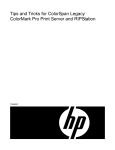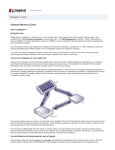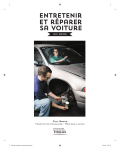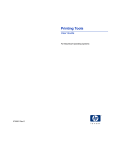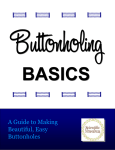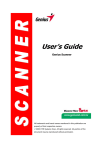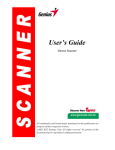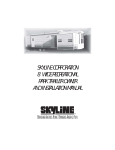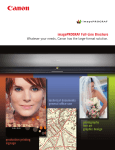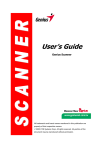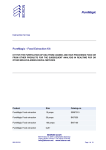Download to the PDF
Transcript
Art Print Express presents: Beginning Art Marketing Online It’s Not as Hard as You Think A step-by-step guide for artists www.ArtPrintExpress.com | www.ArtMarketingOnline.com Beginning Art Marketing Online It’s Not As Hard As You Think Contents First of all, whatever you do, DON’T GET OVERWHELMED by all of the information ...................... 3 Marketing: an overview ........................................................................................................................................................ 3 What is marketing? ....................................................................................................................................................... 3 Time, how much time should you spend marketing? ..................................................................................... 3 You are the best person to market your work. .................................................................................................. 4 Creating value ...................................................................................................................................................................... 4 Are you making GREAT ART? ................................................................................................................................... 4 Do you treat your art with care?.............................................................................................................................. 5 How do you talk about your artwork? .................................................................................................................. 5 Marketing Today: more opportunities for you....................................................................................................... 5 Traditionally art marketing consisted of a limited number of options for the artist ........................ 5 Continue to do the traditional offline tasks much as you have always done them ............................ 6 This new set of opportunities online opens up a whole new world ......................................................... 7 Building your online foundation offline ......................................................................................................................... 8 Rewrite your artist biography and statement ........................................................................................................ 8 Relax: Let the Words Flow Freely ........................................................................................................................... 9 Take Great Digital Photos ................................................................................................................................................ 9 Prints for profit .................................................................................................................................................................. 12 Take advantage of the newest technology available to artists with giclée prints............................. 12 Write about each piece ................................................................................................................................................... 13 The words you use are important ......................................................................................................................... 13 Price Your Work ................................................................................................................................................................ 14 Keep a Database of Your Work.................................................................................................................................... 15 Document Your Buyers, Galleries, Exhibitions and Competitions ............................................................... 15 Building Your Online Marketing Presence .................................................................................................................. 16 Join a Social Network ...................................................................................................................................................... 16 Go to Facebook.com and join the network ........................................................................................................ 16 Upload Your Email Contact List ............................................................................................................................. 16 ________ Written by Michelle Leivan – MichelleLeivan.com – ArtPrintExpress.com – ArtMarketingOnline.com The author is not affiliated or endorsed by Facebook, FineArtStudioOnline.com, GoDaddy.com or any other website other than the three mentioned above. This book is for information and education purposes. There is in no way implied or guaranteed art sales or success by using the instructions within this document. Use at your own risk. 1 Beginning Art Marketing Online It’s Not As Hard As You Think Start Searching and Discovering............................................................................................................................ 16 Start Sharing and Posting ......................................................................................................................................... 17 Show Your Character.................................................................................................................................................. 17 Be Social but be Safe ................................................................................................................................................... 17 Finally, Don’t Create Drama..................................................................................................................................... 17 Create a Facebook Fan Page ......................................................................................................................................... 18 Think of this page as a mini webpage.................................................................................................................. 18 Admin Panel. .................................................................................................................................................................. 18 Your profile picture and your cover image ....................................................................................................... 19 Use Applications to increase interaction and automate .............................................................................. 19 Showcase your latest photos................................................................................................................................... 20 Set Email Notifications............................................................................................................................................... 20 Interact as your page. ................................................................................................................................................. 20 Stay informed with Facebook. ................................................................................................................................ 20 2 A domain name can be assigned to your Facebook Page. ........................................................................... 20 Connect by Email .............................................................................................................................................................. 21 Collecting email addresses of your patrons and supporters is vital ....................................................... 21 Use an online email service. .................................................................................................................................... 21 Get a Website ...................................................................................................................................................................... 21 What do you call your website? ............................................................................................................................. 22 Where to get a website? ............................................................................................................................................ 22 Don’t forget the Meta Tags ....................................................................................................................................... 23 Start Blogging ..................................................................................................................................................................... 23 Consistency and frequency are keys to blogging ............................................................................................ 24 Always have something to say about a new piece.......................................................................................... 24 PayPal .................................................................................................................................................................................... 24 Network your Networks ................................................................................................................................................ 24 Parting Thoughts ................................................................................................................................................................... 25 ________ Written by Michelle Leivan – MichelleLeivan.com – ArtPrintExpress.com – ArtMarketingOnline.com The author is not affiliated or endorsed by Facebook, FineArtStudioOnline.com, GoDaddy.com or any other website other than the three mentioned above. This book is for information and education purposes. There is in no way implied or guaranteed art sales or success by using the instructions within this document. Use at your own risk. Beginning Art Marketing Online It’s Not As Hard As You Think Let me start this off with a question not many artists consider… Are you a capitalist? Does that seem like a strange question to ask an artist? Many artists are uncomfortable considering that label for themselves. I offer that question to you, dear artist, because I truly believe artists are among the last of the GREAT CAPITLALISTS! A Capitalist by definition is an investor of capital (money, energy, emotion, creativity) in business, especially having major financial interest in an important enterprise. If artists create their artwork with the intention to sell the work, then they are capitalists, like it or not. If you had no interest in making money with your artwork I don’t believe you would be reading this. So, welcome and let’s get started on discovering ways to increase the possibility of selling that fantastic work you pour your heart and soul into. First of all, whatever you do, DON’T GET OVERWHELMED by all of the information. Step back and breathe. Remember, everyone with a computer has been exactly where you are at right now. Most importantly, don’t try to do it all in a day, take on only what you feel comfortable with and add things as you get more adept putting your art online. There is a wealth of information online about marketing and what I have done here is given you the essentials of getting started marketing your artwork online. I have consolidated fifteen years of my own experiences of marketing the gallery and my own work online to give you the very basic bare bones, where to get started, and how to do it. Keeping that in mind, let’s get started… Marketing: an overview What is marketing? It is basically EVERYTHING you or others do to sell a piece of your artwork. This can be as simple as talking or writing to people about your work or your life as an artist. It is the time you spend seeking new galleries and places to show your work. The time you spend photographing your artwork to send it off to a new competition is marketing. If you think about it, you probably spend an awful lot of time marketing already and didn’t even realize that is what you were doing. Time, how much time should you spend marketing? I would say 50% of your “art” time should be spent doing some kind of marketing if you want to see results. Target and plan the time you spend in your marketing as carefully as you spend in creating the artwork you are marketing. Set aside a specific time each day or week to work on your marketing. I bet you are thinking, “Oh that seems like a lot of time that I would rather spend creating. Can’t I just get someone to spend their time marketing my work?” Well, you could but I don’t believe that is the best idea. Let me explain. ________ “Set aside a specific time each day or week to work on your marketing.” Written by Michelle Leivan – MichelleLeivan.com – ArtPrintExpress.com – ArtMarketingOnline.com The author is not affiliated or endorsed by Facebook, FineArtStudioOnline.com, GoDaddy.com or any other website other than the three mentioned above. This book is for information and education purposes. There is in no way implied or guaranteed art sales or success by using the instructions within this document. Use at your own risk. 3 Beginning Art Marketing Online It’s Not As Hard As You Think You are the best person to market your work. First of all YOU are your work. If you create something it is as much a part of you as if you gave birth to it. There is not another person on earth who knows your work better. Because of this fact, you should have complete control of how your work is presented and what is said about your artwork. It is your responsibility to protect it and your integrity. Of course, other people can help you with your marketing efforts and you should look at galleries and competitions as partners in marketing your work. Make sure though, that they are working with your marketing plan and not putting words in your mouth about what your work is about. What I want to encourage you to do with this e-book is to create a brand that is YOU. Surround yourself with supporters that will help you succeed in selling your work with value. Creating value As you prepare to market yourself, here are a few more questions to consider. Does your work have value? How do you know if your work has value? Let’s explore this idea of value by considering a few questions. Are you making GREAT ART? Or maybe, what is great art and am I making it? 4 Great art has MAC: Mystery – there has to be some mystery to a great piece of art such as the Mona Lisa, why is she smiling like that? This attribute draws the viewer deeper into contemplation of the piece. Without mystery the art will fall out of style and will not stand the test of time. “Your art deserves your respect, if you don’t respect it, no one will.” Attention – Art must grab the attention of the casual glance and across the room. It must engage the viewer and make it difficult to look away or be powerful enough to reengage the viewer by being unforgettable. Connection – The viewer must be able to find a personal connection to the art. This personal connection is the most powerful piece of the triad because it is what makes people want to possess the piece and purchase it, giving the artist the ability to fund their work and make more art. The concept of great art is subjective in that each artist and each viewer defines for themselves which piece is GREAT and which piece can be ignored. And this is one of the qualities of art that is the most slippery. This is also why you as the artist want to have some control over what is said about your art and why you make it. I have seen a piece sell simply because it was a beautiful, well-executed piece and it resonated with the buyer and then I’ve seen not-so-well-executed pieces sell simply because the subject of the piece resonated with the buyer. So, technical execution is not the be-end-all of making a piece ________ Written by Michelle Leivan – MichelleLeivan.com – ArtPrintExpress.com – ArtMarketingOnline.com The author is not affiliated or endorsed by Facebook, FineArtStudioOnline.com, GoDaddy.com or any other website other than the three mentioned above. This book is for information and education purposes. There is in no way implied or guaranteed art sales or success by using the instructions within this document. Use at your own risk. Beginning Art Marketing Online It’s Not As Hard As You Think GREAT! There are as many reasons for a piece to sell as there are individuals willing to buy the piece. What is important is that you are making and presenting absolutely the best work you have to offer. Do you treat your art with care? Your art deserves your respect, if you don’t respect it, no one will. Use high-quality materials that will make your work last for future generations. When you store or transport your piece, treat it as if it belongs in a museum. Wrap it carefully in plastic and protect it with a soft blanket or towel. Of course, you shouldn’t lean it against any surface that may harm the piece. When complete, don’t touch it with your fingers. When handling the piece, do not place it above a direct heat source or in direct sunlight. The environment for storage or hanging should not be excessively damp, hot or cold. How do you talk about your artwork? Surely you don’t pick out every flaw and misgiving you have about a piece when talking about your work. If you do – then for crying out loud STOP! Think and speak positively about your work. Don’t let slip how easy it was for you to create – because a buyer doesn’t want to hear that. I guarantee it wouldn’t be easy for them. When you talk about your artwork, you should treat it with the same respect as you would when talking about your best friend in a recommendation. This is one reason you should write about the piece in the documentation to make sure you have sat down and really thought about the piece and made the argument to yourself what makes the piece GREAT. Marketing Today: more opportunities for you Traditionally art marketing consisted of a limited number of “Your offline marketing options for the artist, those options depending on the elite tools are the building concierge who “knew what art was and what it was not.” There blocks for your strategy to was a mystique surrounding the art industry masterfully successfully market you created by the gallery owners and high-end art buyers who and your artwork online.” placed an enigmatic veil onto the meaning of art and its value. The marketing was so good that the average citizen was intimidated into not collecting fine art and that it was a job for the rich and educated. This strategy was necessary because there were fewer artist reps and gallery owners than there were artists, so only a handful of artists were represented. Those artists who were being sponsored by the concierge had to be special, important and worth a whole lot of money. It was important that they sold the work for a mint because there were many people depending on those sales for a livelihood. Well, my artist friend – those days, “they are a-changing.” With the dawn of the Internet, the world we live in has changed dramatically and with that change the keys to the caretakers of the elitist art industry have been stripped to some degree. They no longer control the industry; that responsibility is now in the hands of the artists who, in many cases, are unaware that they have just been handed the keys to their future. ________ Written by Michelle Leivan – MichelleLeivan.com – ArtPrintExpress.com – ArtMarketingOnline.com The author is not affiliated or endorsed by Facebook, FineArtStudioOnline.com, GoDaddy.com or any other website other than the three mentioned above. This book is for information and education purposes. There is in no way implied or guaranteed art sales or success by using the instructions within this document. Use at your own risk. 5 Beginning Art Marketing Online It’s Not As Hard As You Think This is why I started the blog “ArtMarketingOnline.com.” I have over 20 years of experience in advertising and marketing and I have spent the last 5 of those years immersed in marketing other artist’s work in a gallery setting. I have seen the industry from the front and the back which has inspired me to offer my insight and practical knowledge to my artist friends. You will see a lot of online marketing information on my blog; however, don’t ignore the traditional offline marketing if you as an artist are to succeed in this new world of self-promotion. Here are a few things you need to keep in mind while working your plans for your marketing. The traditional offline marketing translates nicely into the online marketing if you take a look at them in this way. Traditional “Offline” Marketing Galleries and other Show Places Postcard and Business Cards Online Marketing = Website = Email 6 “With the dawn of the Internet, the world we live in has changed dramatically and with that change the keys to the caretakers of the elitist art industry have been stripped to some degree.” Word of Mouth = Social Networks Introduce Yourself as an artist and = Blog talk about your work Continue to do the traditional offline tasks much as you have always done them. The offline promotional work is the foundation for all of your online marketing. If you have not already done so, please go to my “Art Marketing Online” webpage and opt in to my newsletter. You will receive “Start Here with Your Online Marketing” which will give you three foundational elements that are essential to beginning your online marketing presence. However, those steps are here in this ________ Written by Michelle Leivan – MichelleLeivan.com – ArtPrintExpress.com – ArtMarketingOnline.com The author is not affiliated or endorsed by Facebook, FineArtStudioOnline.com, GoDaddy.com or any other website other than the three mentioned above. This book is for information and education purposes. There is in no way implied or guaranteed art sales or success by using the instructions within this document. Use at your own risk. Beginning Art Marketing Online It’s Not As Hard As You Think document as well, with more detail. So, please help me out and forward it to a friend and ask them to join. This new set of opportunities online opens up a whole new world of people who will love your work. On Facebook alone there are more than 500 million potential patrons of your work. This is one reason I recommend starting your online endeavors with this particular social network. How do you think that will impact the caretakers of the art industry and the artists who would not necessarily be represented by the galleries or the art reps? The way I see it, the Internet, can be a tool for you as an artist to build your patron base and to prove to the caretakers that your work is significant and that you should be the one represented. Those coveted galleries and art reps are still vitally important and will be just as valuable to your career. I anticipate they will not become a thing of the past because they have access to the same tools you do for online marketing. They have been in the marketing game for quite a while already and will make an excellent partner in your own art marketing strategy. 7 ________ Written by Michelle Leivan – MichelleLeivan.com – ArtPrintExpress.com – ArtMarketingOnline.com The author is not affiliated or endorsed by Facebook, FineArtStudioOnline.com, GoDaddy.com or any other website other than the three mentioned above. This book is for information and education purposes. There is in no way implied or guaranteed art sales or success by using the instructions within this document. Use at your own risk. Beginning Art Marketing Online It’s Not As Hard As You Think Building your online foundation offline Your offline marketing tools are the building blocks for your strategy to successfully market you and your artwork online. This section is created to help you get started with the items you will need to develop and organize offline before implement your online marketing plan. You will need to create several different documents to help you keep focused on how you want to present yourself online. These documents are important to spend time doing and making sure they say exactly what you want to say about your artwork in a way that will draw people not only to your artwork but also to become a fan and buy your work as well. Rewrite your artist biography and statement This important document is traditionally used for printed pieces will be a tool that you can use to present yourself online. What I’m going to ask you to create here is an artist statement which is slightly different than the traditional statement that encompasses the scope of a body of work. This statement will include biographical elements as well as a description of your work. 8 When writing your statement, consider what distinguishes yourself from other artists. There are literally millions of artists out there online. Below are parts of two actual artist biographical statements. Read these real life examples of artist biographies and ask yourself if which artist’s work would you click on to see more? For the purpose of this illustration, I have made the names and places generic. [Artist Name], a [Home Town] artist, creates art almost every day, working with oil paint, pastel, or clay. [Artist] loves to en plein air paint in oil, with architecture as preferred subject matter. [He] also creates abstract paintings, usually in an organic way. [He] also portrays antiques in pastel, and keeps [Him] extra busy making functional ceramics. Now this one: Fascinated with the weather, [Artist Name] captures the beautiful scenic hills with the sharp contrasts of an oncoming thunderstorm or a simple far-off cloud in pastel. [His] distinctive illustrative style provides an ethereal sensation, creating a countryside filled with the pleasure of quilted comfort accompanied by a sky filled with an awe-inspiring weather event. I personally know both of these artists, and I’ll tell you they both do fantastic work, both should be seen and appreciated. Sadly with these two introductions to them, I want to know more about the second artist and I would probably skip the first one because is so generic it could be nearly any artist. The second one lyrically and uniquely describes the work and the artist in a way that does justice not only to the work, but to the artist as well and encourages the reader to go take a look at that work. ________ Written by Michelle Leivan – MichelleLeivan.com – ArtPrintExpress.com – ArtMarketingOnline.com The author is not affiliated or endorsed by Facebook, FineArtStudioOnline.com, GoDaddy.com or any other website other than the three mentioned above. This book is for information and education purposes. There is in no way implied or guaranteed art sales or success by using the instructions within this document. Use at your own risk. Beginning Art Marketing Online It’s Not As Hard As You Think Relax: Let the Words Flow Freely The easiest way is to start off with some “free writing.” This is a technique where you spend at least 10 minutes writing about what you want to say (since, as an artist you are most likely a “hands-on” kind of person I suggest paper rather than keyboard.) Don’t worry about spelling or grammar, and just get the words down onto paper. Let it simmer for a couple of hours or days, then come back and see if you can find a way to put the words into a statement that says exactly what you want to say about your work. If you are struggling, seek the help of a writer friend who can put down into words what you want to say about your artwork. But, you have to do the free writing exercise first so that you can give the writer some kind of direction. Items to include are: Education Art Accomplishments Awards Other facts of interest that sets you apart from other artists. Why you create Once you have down what you want to say about your work turn it into two documents, one being a 200 and the other a 500 character description, think of them as a 30 second and one minute commercials. You will need these two versions in various places with your online marketing, some places accept only 200 characters and others allow more. Take Great Digital Photos “The camera’s lenses and the image sensor are the keys to a good reproduction photograph of your work.” Creating quality digital images of your artwork is much easier today than it used to be. With the improvements of digital cameras, artist control over the image and reproductions provide a low cost opportunity to make your artwork more accessible to more collectors both on and offline. The instructions below are certainly not the only way to photograph your work, but it is simple and consistent method that with just a little practice you will be able to photograph your artwork with confidence, and using them in a variety of ways including digital prints. Two things to consider when digitizing for print: The camera’s lenses and the image sensor are the keys to a good reproduction photograph of your work. For instance, cell phone cameras are quickly becoming capable of taking a 5 megapixel photograph; this does not mean that it should be the camera you choose to use for photographing your work for print reproduction. Choose a namebrand digital camera with a quality lens and a quality images sensor. We use a Canon EOS 60D SLR camera to digitize for print here at Art Print Express. However, this is not the only camera available that can give you satisfying results. A knowledgeable camera store clerk can be a great source of information. ________ Written by Michelle Leivan – MichelleLeivan.com – ArtPrintExpress.com – ArtMarketingOnline.com The author is not affiliated or endorsed by Facebook, FineArtStudioOnline.com, GoDaddy.com or any other website other than the three mentioned above. This book is for information and education purposes. There is in no way implied or guaranteed art sales or success by using the instructions within this document. Use at your own risk. 9 Beginning Art Marketing Online It’s Not As Hard As You Think Equipment: Digital camera (5 megapixel or more) with digital card and built-in time delay feature or remote shutter release. Tripod 2 Clip Lamps with cool “Daylight” bulb. (Check your local camera store for the fluorescent 5700K daylight bulbs. When running these bulbs are not hot to the touch.) 2 light diffusers (you can buy shower cap looking diffusers that fit your flood lamps or you can simply use two thin white trash bags to drape over your flood lights – Only if you are using the cooler to the touch florescent bulbs in your clamp lamps.) Computer with Image Editing Software (of course Adobe Photoshop is great, but, see Gimp.com for a free option) Digital Media Card Reader – Optional. You will need this if your computer does not have a media reader compatible with the digital media your camera uses. (The media reader allows you to connect CompactFlash, Smart Media, etc., to your computer.) Procedure: 10 1. Remove any glass from the artwork. Hang your artwork. Use a level to make sure your piece is square with the floor and the wall. Set your camera to make the largest image size available for the camera. Any setting over 5 megapixel will make a reasonably good-sized print, maybe not a giant print, but it will accommodate an average size like 16”x20”. 2. Mount lights as close to the same height as the center of the painting, directed toward the center at 45° angles and far enough away to evenly light the piece without glare or hot spots. Set the white balance of your camera to match the type of light you are using or set a custom white balance according to your camera user manual. If you are using the 5700K daylight bulbs, the “daylight” setting will work. Properly setting the white balance will greatly improve the accuracy of your color. 3. Mount the camera on a tripod and adjust the height of the lens to the center of the artwork. Fill the artwork in your view finder and use as little zoom as possible. Do NOT use any digitally assisted zoom feature, this will only create more noise and your image will not be clean. You can move your tripod closer or further away to fill the view finder with the image. ________ As you look through the view finder or at your LCD display, look for any glare from the lights; adjust the lights to minimize the glare. On dark paintings, turning the lights around and bouncing the light off of a white wall or large piece of paper can eliminate troublesome glare spots. A circular polarizing filter can be used also but is an additional accessory for most cameras. Also carefully check all corners for any parallax distortion or fisheye effect. Adjust camera to fix these. Written by Michelle Leivan – MichelleLeivan.com – ArtPrintExpress.com – ArtMarketingOnline.com The author is not affiliated or endorsed by Facebook, FineArtStudioOnline.com, GoDaddy.com or any other website other than the three mentioned above. This book is for information and education purposes. There is in no way implied or guaranteed art sales or success by using the instructions within this document. Use at your own risk. Beginning Art Marketing Online It’s Not As Hard As You Think 4. Once your camera is set, engage the focus and exposure metering by depressing the shutter release half way. You can use a one of your Program Modes from your camera presets or for a camera with manual exposure, try an aperture at F8 - F11 and set the shutter speed for a correct exposure. Use your built in time-delay to trigger the shutter to eliminate any blur. Setting the F stop up to 22 will create long exposure times. There is some concern for long exposure time which can cause a blur but only if something bumps the tripod. To relieve that concern, use F8-11 to shorten the exposure maintaining the sharpness. The beauty of digital cameras is that you can shoot several and experiment with subtle settings and see your results immediately. 5. When you are comfortable with your camera settings, fully depress the shutter release to make the exposure. Preview the image in the LCD to determine if any adjustments need to be made. I would suggest trying many combinations of exposures and lighting before you commit to keeping the image. 6. Transfer the image(s) to the computer directly from your camera with a USB cord or with your media card reader. Open your image with the editing software. Here is another advantage of digital imaging, being able to make corrections. You can crop, straighten, square off the fish-eye effect and correct the image parallax effect with minimal image loss. 7. Compare the image on your computer with the painting. Make sure you are looking at it under the same light situation in which it was photographed. Make any color adjustments as needed. Save this as the original and it is ready for the printing process. For the web size the image to 72 dpi with the longest side at 500 pixels, at this size you do not have to worry about anyone making reproductions of your piece. A downsized photo for the web will probably need a little extra sharpening. Save the web image as a separate image file. Note: Every monitor is different, so everyone will see your piece a little differently depending on their monitor. There is nothing you can do about this other than take the best photograph you can and make it look its best on your monitor. Of course, there are all sorts of monitor and printer calibrators available and if you are displaying these on a website, the calibration is all for naught. However, if you are photographing for print, you should consider their equipment, because the person printing the piece will not have the same monitor as you either and their work flow will be calibrated for their specific equipment. The good news is, if the color looks good on your monitor, there is enough information for the printer to get a close match. Ask for a proof before committing to the full sized print or bring the original for color matching. This subject can expounded on in great detail with many other options, but my intention for this guide is to get you started without breaking the bank and give you some insight on what it takes to ________ Written by Michelle Leivan – MichelleLeivan.com – ArtPrintExpress.com – ArtMarketingOnline.com The author is not affiliated or endorsed by Facebook, FineArtStudioOnline.com, GoDaddy.com or any other website other than the three mentioned above. This book is for information and education purposes. There is in no way implied or guaranteed art sales or success by using the instructions within this document. Use at your own risk. 11 Beginning Art Marketing Online It’s Not As Hard As You Think digitize art work. This is the basic process that I use in the print studio with success. With a little experience and experimentation, you too can digitize your work with confidence. Prints for profit I remember the first thing I learned when studying how to market online, “If you can reproduce it easily, you can sell it online.” This concept works fantastic for the two-dimensional visual artist. Seriously consider prints as a profitable option for your online market. Not only does it extend the profit margin on each piece, it also makes it possible to offer your work at a price that will build confidence for your online collectors. Take advantage of the newest technology available to artists with giclée prints. Giclée – pronounced “zhee-clay” is a derivative of the French word “gicler” meaning “to spurt”. It is a coined term for the process of making high quality fine art prints from a digital source using ink-jet printing. Artists generally use giclée inkjet printing to make reproductions of their original two-dimensional artwork, photographs or computer-generated art. 12 The process to create a “giclée print” represents a relatively new advancement in printmaking technology and produces better color control and accuracy than any other current means of image reproduction. Original artwork is translated digitally with high resolution scans, digital cameras or computerized art programs and printed using professional color ink-jet printers. High quality archival inks are used on a variety of surfaces including canvas, fine art papers and photo papers. The quality of “The quality of the giclée print the giclée print rivals traditional silver-halide and gelatin rivals traditional silver-halide printing processes and is commonly found in museums and gelatin printing processes and galleries. and is commonly found in For artists this process is most advantageous because they museums and galleries.” can reproduce their artwork on-demand with minimal effort and manageable cost. The high cost of mass production for an edition is eliminated and each image can be printed on demand as they are sold. The digital files are archived until they are needed and will not inherently deteriorate as does the older film process. Also, with the giclée process a print can be made to accommodate a variety sizes and onto a variety of media, which gives the artist other options for customization with each client. It all starts out with a great digital photo and find a great giclée printer (Insert shameless plug for ArtPrintExpress.com here.) ________ Written by Michelle Leivan – MichelleLeivan.com – ArtPrintExpress.com – ArtMarketingOnline.com The author is not affiliated or endorsed by Facebook, FineArtStudioOnline.com, GoDaddy.com or any other website other than the three mentioned above. This book is for information and education purposes. There is in no way implied or guaranteed art sales or success by using the instructions within this document. Use at your own risk. Beginning Art Marketing Online Write about each piece It’s Not As Hard As You Think Once you have photos of your artwork, you will want to have something to say about each of these wonderful pieces you have turned into digital images. This is something you will want to consider before you post any piece online. Although every picture is worth one thousand words, without words and proper descriptions your images are not searchable online. For people to find you online, it takes words for your piece to be found. This concept is so important to your online presence, I cannot stress it enough. You must know what you want to say about your work and be able to put it down in words. This is the real “work” of marketing yourself and your artwork. Not only do you want to talk about each piece it is important to put key words and phrases in each description. The first 200 characters or so in a description or an article usually accompanies a link to give the viewer some information about the link they are about to click. So if you put a description which includes the material, size and framing of the piece, put that information further down on the description. The first few words need to create interest in your piece, entice them to click and explore your work. The description below is 512 characters long with spaces. The description picked up with an online link to the page will most likely be the words in bold. This is an important feature to consider when posting on Facebook. This trio of Pale Poppy Mallow is presented with a blue-green background. I am not sure why I chose to paint this Pale Poppy Mallow at this time. Maybe I needed a break from my Echinacea. I remember photographing this set. I took several pictures trying to get the right angle and lighting to capture their “Although every picture is character. They are grouped in protection but still worth one thousand words, hold their own personality. This set makes me think of the closeness of my family of three and individual without words and proper growth that is safely nurtured in our home. descriptions your images are not searchable online.” If someone was searching for a painting of Pale Poppy Mallows, there is no question they have just stumbled upon what they are looking for. If it is on your website or on a Facebook Page, the search engines spiders also know that the page contains a painting of pale poppy mallows and will gladly point them to the piece. When typed in the search bar for Google “pale poppy mallows painting” the link to this piece comes up as 4th and 6th on the list. (My website has two views so there are two links available for the search engine droids to find the piece.) The words you use are important; you have to think like the person searching for a piece like yours. For example, another piece of mine when searched “crimson faced sunflower” comes up number one and that is because it is on the US Art in Embassies program which is a government site. (Google gives preference to government sites, which is good for my piece.) However, if “crimson sunflower painting” is searched the same piece but on my own site comes up on the second page. These listings change daily and can be affected by any cookies that Google uses to track your ________ Written by Michelle Leivan – MichelleLeivan.com – ArtPrintExpress.com – ArtMarketingOnline.com The author is not affiliated or endorsed by Facebook, FineArtStudioOnline.com, GoDaddy.com or any other website other than the three mentioned above. This book is for information and education purposes. There is in no way implied or guaranteed art sales or success by using the instructions within this document. Use at your own risk. 13 Beginning Art Marketing Online It’s Not As Hard As You Think preferences. Is “crimson” the best word to use in my description? Maybe, but if someone is looking for a red sunflower rather than a crimson sunflower they will never be offered my page as an option. Revisions need to be made, however I will leave this description alone so everyone can learn from it. There is a lot more to know about search engine optimization; this basic concept should get you on a good start to getting your work found online. Price Your Work The first thing I want to say about pricing is that you have to know what you want for your piece. To not know how much you want or need for a piece is like getting caught with your pants down. Pricing is a subjective as art is. So here are a few things to consider when setting a price for your piece. Pick a base price for every piece you do -- consider all costs, time, materials, education, promotion, membership, framing and contest fees. Then, figure how many pieces you can do a year, divide costs by number of pieces and this is your base price. 14 For an example let’s say your base price is around $250 no matter what size a painting is this is, 5"x5" or 60"x60" this is where you start your price for each piece (I like to think of this as the cost for you to even touch the canvas,) then add at square inch price. Then let’s figure a cost per square inch $.50 per square inch. If you piece is 15x15.5 =232.5 square inches so 232.5x.50 = 116.25 “No matter where you have your work for sell, always price with consideration of giving a gallery 50% and that price needs to be consistent whether you are selling the piece at a gallery or out of your studio.” So $250 + 116.25 = 366.25 so maybe round up to 375 to 400 --- then ask yourself are you comfortable with receiving half of that if you are represented by a gallery? If the answer is yes, then go for $400. If not adjust the $.50 until you get comfortable with the price at 50% --- look at the half that would go to a gallery as the commission for selling the piece. Remember this: the dollar value of a piece is determined only by the buyer. An art lover must release their hard-earned cash in exchange for your artwork. That does not mean you do not have any control over the price you set on a piece. The things you want to ask yourself are: How badly do you want to sell the piece? And would you rather keep storing the piece? For early sales, you will want to keep your prices low and allow your collectors to pay for you to grow as an artist. The best news is that once someone buys your work, they will most likely buy another. Then there is the social effect, people like to talk about their art and at the minimum one of their contacts will also buy a piece. There is magic that happens when people start buying. ________ Written by Michelle Leivan – MichelleLeivan.com – ArtPrintExpress.com – ArtMarketingOnline.com The author is not affiliated or endorsed by Facebook, FineArtStudioOnline.com, GoDaddy.com or any other website other than the three mentioned above. This book is for information and education purposes. There is in no way implied or guaranteed art sales or success by using the instructions within this document. Use at your own risk. Beginning Art Marketing Online It’s Not As Hard As You Think If you are already somewhat established, you will want to consider these things: Aesthetic and technical merits, the cost of recovering costs of producing and marketing the artwork, your artist's reputation and demand for the work. No matter where you have your work for sale, always price with consideration of giving a gallery 50% and that price needs to be consistent whether you are selling the piece at a gallery or out of your studio. The reason I say this is, if you are selling your piece at a 50% reduction out of your studio, why would anyone buy a piece at the gallery? And then why would the gallery ever consider carrying your work. Galleries are your partners in your sales and marketing; please don’t cut their legs off at the knee. Simply consider the other 50% your personal commission when selling a piece out of your studio. And if I know typical artists, you are probably cutting yourself short as well by giving deep discounts in the studio and not taking that “commission” from yourself. Give yourself a break and know your prices, it’s nothing more than business. If you have two galleries with different commissions, then tell them what your retail price is, and you will simply get a better rate at one gallery over the other. Insist on the continuity for your pricing… it’s your work. Don’t get enamored with the thought of being in a gallery and allow them to step all over you with their demands; this is a partnership and you are the one who has the most to lose. Explain how you set your prices and if they cannot accept your terms, maybe there are other unseen reasons you shouldn’t do business with them. I know it is a hard situation to be in, but in my life experience, that first disagreement will tell you a lot about a relationship. So pay attention. Keep a Database of Your Work Carefully document each piece with a photo, price, size, medium and a statement that makes it unique. There are several artist database programs out there, or create your own system. Make sure the information is easy to access and maintain. You should not have to launch a search and rescue mission when someone asks for a price or asks you questions about your technique or subject. This is another organizational task that is in your own best interest. I have all of my work that is available on my website. So, my website is my database, it’s available to me and the world 24/7, so maybe it isn’t so difficult to keep a database of your work. Document Your Buyers, Galleries, Exhibitions and Competitions Keep a database of your collectors, patrons and exhibition history. Make sure you get the buyer’s contact information, and make sure the historical documentation of each piece goes home with the patron, along with your contact information. This would be whether you sell it from your studio or in a gallery. Always get the emails of people who show interest in your work. You never know when a buyer will be ready to purchase and you’ll be marketing to them with their email contact information. Of ________ Written by Michelle Leivan – MichelleLeivan.com – ArtPrintExpress.com – ArtMarketingOnline.com The author is not affiliated or endorsed by Facebook, FineArtStudioOnline.com, GoDaddy.com or any other website other than the three mentioned above. This book is for information and education purposes. There is in no way implied or guaranteed art sales or success by using the instructions within this document. Use at your own risk. 15 Beginning Art Marketing Online It’s Not As Hard As You Think course much of this information about buyers, galleries, exhibitions and competitions needs to be on your artist resume as well. I’m going to leave this up to you. You can choose to do it all by hand on index cards, keep it in your email contacts or make your own spreadsheet. A good artist database program will work for this. Again, I have all of this on my website service and in my Yahoo email account in my “contacts.” After you have these items down, you are pretty much ready to start posting your work online, whether on your website, on your blog or in a social media setting. Building Your Online Marketing Presence I know I have asked you to do a lot of things before going online, however, these things you will thank me for later. Most artists I see online do not do all of this work and I believe their online sales will reflect the neglect. It’s all up to you. Join a Social Network 16 To start with your online marketing I want you to join a social network. I have chosen Facebook as the tool of choice here because Facebook seems to have everything you need to get started all in one place. There are also potentially 500 million patrons to market to. Once you are comfortable with this network, you can expand your plan to include other online services such as Pinterest, but Facebook is where I want you to get started. Go to Facebook.com and join the network and get a profile if you aren’t on there already. “Always post a picture of your artwork with Title, Size, Medium the © symbol and your name on the description of each if work pictures. Add your website, e-store or gallery if applicable.” Upload Your Email Contact List. This is your contacts in your email program. You will want to continuously grow this list as it will be a great tool for all of your online marketing efforts. You want to collect these from various sources while making sure it is permission based. In other words do not put random people who you do not know very well on your list, you will only get blocked and you want to make sure you are marketing to people interested in your artwork. You will want to keep the list in your email program as well as here on Facebook. Start Searching and Discovering. If you are new to Facebook I want you to take a few days and poke around to get used to the interface. Do a few searches for groups and businesses you might find interesting. Look for other artists that inspire you. Interact with them and ask for their friendship. With the new timeline feature it is easier than ever to showcase your work. Set up a profile picture and set your cover image. ________ Written by Michelle Leivan – MichelleLeivan.com – ArtPrintExpress.com – ArtMarketingOnline.com The author is not affiliated or endorsed by Facebook, FineArtStudioOnline.com, GoDaddy.com or any other website other than the three mentioned above. This book is for information and education purposes. There is in no way implied or guaranteed art sales or success by using the instructions within this document. Use at your own risk. Beginning Art Marketing Online It’s Not As Hard As You Think Start Sharing and Posting. Do a few posts, share your artwork. When you post your work anywhere online: Always post a picture of your artwork with Title, Size, Medium the © symbol and your name on the description of each if work pictures. Add your website, e-store or gallery if applicable. Show Your Character. Your profile will allow you to have a maximum of 5000 friends, no more. This is not where you are going to be doing your marketing. This is about you as a person, not just about your artwork; you can post the fantastic pie you baked for Christmas, or the cutest picture of your cat sleeping in the chair and your favorite quote. Be Social but be Safe. When working with social networks remember to always be safe. Don’t be afraid of being social, and interact. Post only 30% about your art on your personal profile. Have a special photo album for your artwork; make sure those are good photos too. Always look at the profile of anyone requesting your friendship before you accept them. Don’t be shy about asking for their friendship. Don’t Get too Personal; remember everyone can see what you put out there including your employer and potential buyer. You can be anybody online and so can other people. For example when my husband went off to Iraq for a year, I did not mention him being gone or in Iraq at all because that just opens a woman up to be a victim. Please be smart with your information online, but you don’t have to be paranoid about every detail either. Simply think about what you are posting and decide if you are comfortable with the world “You can be anybody online and seeing it. I could make an Anthony Wiener joke here but I’ll so can other people.” restrain myself, nevertheless he is a good example of not thinking before you put something out for the world to see. Finally, Don’t Create Drama; there isn’t anything more bad-mannered than when people create drama online. If you run across someone who is creating drama for you, you can always hide them in your news feed or block from your friends. Keep a positive and friendly attitude. Drama even on your personal profile isn’t going to help you sell paintings. One particularly rude way people create drama (and a pet-peeve of mine) is called “Vaguebooking.” According to the New Urban Dictionary, “Vaguebooking: Intentional or unintentional vague or ambiguous Facebook status message, which people have no clue as to what you are talking about.” For example “Mary is: wondering if it’s all worth it.” While in reality Mary is bored waiting in a particularly long grocery store line. ________ Written by Michelle Leivan – MichelleLeivan.com – ArtPrintExpress.com – ArtMarketingOnline.com The author is not affiliated or endorsed by Facebook, FineArtStudioOnline.com, GoDaddy.com or any other website other than the three mentioned above. This book is for information and education purposes. There is in no way implied or guaranteed art sales or success by using the instructions within this document. Use at your own risk. 17 Beginning Art Marketing Online It’s Not As Hard As You Think Create a Facebook Fan Page Once you are comfortable with your online profile, you will need to make a Fan Page. There are many reasons to conduct your marketing from Fan pages rather than your profile. First off, they are different from profile pages in that they are searched and categorized by the search engines. You can talk all about your work and nothing else. It’s free advertising. 1. Log in to your profile and scroll all the way to the bottom of the page. You will see a series of inconspicuous links. 2. Click “Create a Page.” This will take you to a new page where you will be given some choices about what kind of page you want to create. 3. Choose on “Artist, Band or Public Figure” and choose your category. 4. You will be asked to select a name for your page, you will want to select something that will be memorable but also contain your name. “Artist [Your Name],” for example. Be descriptive, tell them who you are and what you do. Do not be too generic, if you already have a website, you can use the website name. 18 You can change the title of your page up until you have 101 fans and once you have that many fans your URL is locked in. Simply follow the instructions; they have made this very easy even for the novice. Note: The “Getting Started” page is visible to you as an administrator only. Think of this page as a mini webpage about your artwork and your life as an artist. This is a place where you can talk about your artwork exclusively. Definitely post photos of your work here. Remember to use your copyright information in the caption area. Also consider posting photos of you working on your art and the huge crowd at your most recent show. “One of the great things about the new updates to the Facebook Pages it that you can log in and interact as your page.” If you have a website, post links to your works here rather than posting only photos of your work. Simply cut and paste the information in the address bar from the page you want to share. This will send them back to your website where they can buy rather than just stopping at your Facebook Page. Don’t forget to also share everything you do on your Facebook Page with your Profile friends too. Admin Panel. One of the first things you will notice different about Facebook Pages is that there is a special feature at the top called “Admin Panel” This is an awesome benefit for Pages that allows you to know which posts are working and which posts are not, who is looking at your site, how many people you are reaching and if people are commenting and sharing your information. When built over time, this is an invaluable tool. You will eventually have a specific set of data that defines who ________ Written by Michelle Leivan – MichelleLeivan.com – ArtPrintExpress.com – ArtMarketingOnline.com The author is not affiliated or endorsed by Facebook, FineArtStudioOnline.com, GoDaddy.com or any other website other than the three mentioned above. This book is for information and education purposes. There is in no way implied or guaranteed art sales or success by using the instructions within this document. Use at your own risk. Beginning Art Marketing Online It’s Not As Hard As You Think on Facebook is attracted to your work and you can bet that it is pretty much your demographic because the pool is over 500 million users. Below is a sample from my Michelle Leivan Original Painting page. As you can see although I have only 363 people liking my page, I have a potential of reaching 145,700 people through those 363 people. Do you like the idea of free advertising now? This is the power of Social Media and you will always want to put your best foot forward. 19 Your profile picture and your cover image is the best way to attract attention to your work. You can put subtle prompts on your cover image to send them to your website if you have one, but do not be too blatant or Facebook will flag you. In each post you can encourage them to click one of your navigation links specifically. “Click on “photos” to see my most recent work.” Adding your website address to the photo, it will not put in a hyperlink to your website but you can still give them the address, better yet, post your link from your website so that they have to go to your site to see a larger image and get the details on how to buy your work. Know what you want them to do and ask them to do it. Use Applications to increase interaction and automate. I would suggest seeking additional plug-in type applications available on Facebook to add to your page. There are literally thousands of them and there are already a few on your page. “Photos” “Notes” and “Discussions” are all applications within Facebook. To start your search for helpful applications select “edit page” at the upper right hand side of the page. There is a navigation list on the left side of the page that loads. Click “Apps”, you will then be shown the entire list of applications currently used by your page. Scroll to the bottom of the page and click “Browse more applications” and start exploring. ________ Written by Michelle Leivan – MichelleLeivan.com – ArtPrintExpress.com – ArtMarketingOnline.com The author is not affiliated or endorsed by Facebook, FineArtStudioOnline.com, GoDaddy.com or any other website other than the three mentioned above. This book is for information and education purposes. There is in no way implied or guaranteed art sales or success by using the instructions within this document. Use at your own risk. Beginning Art Marketing Online It’s Not As Hard As You Think You can add and remove these at will. Allow your page to be fluid and add things as you have a need for them. Some applications to consider: You can write notes on your page which acts as a blog. If you already have a blog, you can add the “Network Blogs” application and it will automatically post any new entry onto your Fan Page. Also, if you are on Twitter, there is an application that will auto post your tweets as well. An application called “FBML” which will allow you to put in a little bit of “HTML” if you have an email list collector from a service you can put that in too. There are many applications that you can use to draw people to your artwork and there is even a marketplace application mentioned above so that you can sell your artwork right from Facebook. The best thing to do is to browse the applications to see what all it available. If you have an email service, see if there is a Facebook applications to add to your page from that service and ask people to sign up for your email list. Look for additional Facebook applications to help you, maybe having the “Shop-It” application would be helpful to sell your work if you do not have a web page yet. 20 Showcase your latest photos. Facebook Pages are made for artists. With the new timeline feature, you can highlight your latest image and “feature” every piece or link to your work that you post. Set Email Notifications. Look under “Edit Page” Settings you can set email notifications to let you know when someone posts to your page because when you get people responding to your posts you will want to respond to their comments. You can also build a network of other pages you like and set the featured pages to show on your Fan Page wall. Interact as your page. One of the great things about the new updates to the Facebook Pages is that you can log in, go to your page and select “interact as your page.” So if you find a gallery that you like, you can post a comment on their page as your Fan Page instead of your Profile – which will lead them back to your Page which has all the important information about you and your artwork without all the clutter of everyday life posts on your profile. Stay informed with Facebook. Facebook has made available “Best Practices guides to make your Page engaging.” To find it go into “edit page”, the link is on the left hand side with an orange flag next to it called “resources.” Click on that and it will send you to a number of links including “Best Practices guides to make your Page engaging.” Click on that and you can keep up with the latest and greatest of information about having a Facebook Page. A domain name can be assigned to your Facebook Page. You can even buy a domain name and point it to your Facebook Page. This takes a little more technical skill, but it is not impossible. Simply go to a domain registrar such as www.GoDaddy.com and buy a domain name. (Please see the Website ________ Written by Michelle Leivan – MichelleLeivan.com – ArtPrintExpress.com – ArtMarketingOnline.com The author is not affiliated or endorsed by Facebook, FineArtStudioOnline.com, GoDaddy.com or any other website other than the three mentioned above. This book is for information and education purposes. There is in no way implied or guaranteed art sales or success by using the instructions within this document. Use at your own risk. Beginning Art Marketing Online It’s Not As Hard As You Think section about what domain name to pick.) There is a setting, read the instructions to forward your domain to your Page. If you have trouble, they have wonderful customer service too. Then don’t forget to put a link to your commercial Facebook Fan Page in your email signature. Connect by Email Email marketing is a powerful tool in your online marketing strategy. Although the “in” thing is to be on a social network, not everyone who is interested in your work can be found on one of the social networks. Being able to connect with them through another resource is essential. Keep in contact with everyone who takes notice in your work. Send out show announcements, share your accomplishments, and show them that new piece. Collecting email addresses of your patrons and supporters is vital. Gather emails from every source you can, while making sure you have permission from the address owner. When you meet someone, ask them for a business card. When you have a show, put out a guest book and ask for their name and email address nothing more. Use that a list of friends and family emails and ask them to forward your emails to their friends who would find your artwork interesting. “You want to gather emails from “Your website should be the first place you every source you can, while But don’t stop there… post a new piece and one of the only places making sure you have permission online that your work can be purchased.” Use an online email service. There are two from the address owner.” really good services out there that I have experience with, those are www.constantcontact.com and www.mailchimp.com. I recommend checking both of them out and see which one fits your needs. They both have free trial options so you will not be spending a lot of money to try before you buy. One of the advantages of an online email service is that it can help you with collecting those emails with automatic forms that put the emails captured all in one place. They even have applications to help you gather those emails from your Facebook account. Finally, don’t forget to put a link to your email sign-up form in your email signature along with your Facebook Fan Page. If you have a website, put in a form asking fans to sign up for your show updates and news. A good website service will provide this capability too. Get a Website Over the last decade, a website has become a must-have for the visual artist. It serves several purposes that not only help you promote your work, but it is a single place where people from ________ Written by Michelle Leivan – MichelleLeivan.com – ArtPrintExpress.com – ArtMarketingOnline.com The author is not affiliated or endorsed by Facebook, FineArtStudioOnline.com, GoDaddy.com or any other website other than the three mentioned above. This book is for information and education purposes. There is in no way implied or guaranteed art sales or success by using the instructions within this document. Use at your own risk. 21 Beginning Art Marketing Online It’s Not As Hard As You Think around the world can look at and buy your work. Yes, there are over 500 million people on Facebook, but there are even more who use the web. If you have the funds to get your own website, I highly recommend that you do, and it should be the hub of your online marketing. Your website should be the first place you post a new piece and the only place online that your work can be purchased outside of a commercial gallery site. When you share your work, share the link to your website instead of filling up your Facebook album. If you still want to post the pieces in an album, put your web address in the description too. Remember, when you post your work anywhere online: Always post a picture of your artwork with Title, Size, Medium the © symbol and your name on the description of each if work pictures. Add your website, e-store or gallery if applicable. 22 What do you call your website? Simply YourName.com if it’s available or YourNameArt.com. Most people who like your work will be looking for your name. Your name is your brand; it’s the first, most obvious thing that separates you from other artists. If you have a name that is common or is also a celebrity name, then get a little creative but make sure your name as signed on your pieces is part of the domain name and you can use a descriptor word such as “art” or “photography” or “gallery.” Just make sure it fits your work. Be sure to do a little research on whether or not your name is available. Go to www.GoDaddy.com and use their domain search. If your name is not available they will give you some suggestions as well. Your choice of domain name is very important to your branding and marketing. Where to get a website? If you do not already have a website or are looking for a new host, check out www.FineArtStudioOnline.com (FASO.) This is a service I use for my own personal art website, have been with them for over 6 years and I highly recommend it. It is designed especially for artists who want to have a website. I believe if you can make your way around Facebook, you can most definitely use this website with ease. They have several templates to get you started right away and you do not need to know HTML (Hyper Text Markup Language.) You only need to know how to fill out a form online and upload photos. They will even help you buy a domain name if you choose the “Professional” or “Master” level of service. Once you pick a level and start using the service, you also become a member of their network. FASO offers art marketing advice through a weekly newsletter and offers several ways to increase your online presence, including “Facebook ‘Like’” for every one of your pieces you offer online (make sure you pick an enhanced template to get this feature – what’s great about this feature is once you have put a piece onto your website, you can just click ‘Like’ and it posts to your Facebook profile!) They have a built-in email newsletter service and a blogging section as well, all in one place. I cannot say enough about how great this service is, especially for the novice. Their customer service is fantastic too, so no worries if you run into a problem. ________ Written by Michelle Leivan – MichelleLeivan.com – ArtPrintExpress.com – ArtMarketingOnline.com The author is not affiliated or endorsed by Facebook, FineArtStudioOnline.com, GoDaddy.com or any other website other than the three mentioned above. This book is for information and education purposes. There is in no way implied or guaranteed art sales or success by using the instructions within this document. Use at your own risk. Beginning Art Marketing Online It’s Not As Hard As You Think When you start uploading your pieces, remember all of the off line work I asked you to do before you started going online? Well, this is where you want to use all of these things. Make sure you have something to say about your piece. Don’t forget the Meta Tags. There is a very important section on the website you will not want to neglect. Meta Tags are built into your webpage by the template and are descriptive words that help Search Engines know what is on the page. Start off with a short and distinct description of your website this will be the “Meta Tag Name.” Then fill out the “Meta Tag Content” which consists of a list of one- and two-word phrases that describe you and your artwork. To help you determine your content: Write a few keywords about your work. Look at your artist biography. Consider what people say about your work For example, let’s say you are a Kansas artist and have an affinity for painting en plein air landscapes of the Colorado Rocky Mountains. First make a list of any details that will help someone find your work if they want the kind of work you do. Your list might look like: “Your Name, Kansas, artist, Colorado scenes, oil, acrylic, rocky mountains, Denver, landscape, painting, en plein air.” Continue your list capturing as many details you can think of that someone might type in a search box to find your work on the web. This is a good place to get you started. There are entire books on Search Engine “If a potential buyer has to contact Optimization (SEO) that can be studied and used. But this you before they can buy a piece, will get you started. then it will be assumed that you If you are expecting to sell your work online, then put your want more than they can afford.” prices online. If a potential buyer has to contact you before they can buy a piece, then it will be assumed that you want more than they can afford. Have you heard, “If you have to ask you can’t afford it.” This is what you will be running up against. So go ahead and post the price and if someone on Facebook falls in love with your piece, then you can sell it right on your website. Start Blogging Blogging is a popular way to get your work seen online. There are many options out there, most of them free, to create an art blog for people who follow you online. Although you can just stay in Facebook and write “notes” about your work, you can get a larger online presence if you choose to also create a blog. (There is an application called “Networked Blogs” in Facebook that will auto post your blog to your profile and/or page every time you update your blog.) ________ Written by Michelle Leivan – MichelleLeivan.com – ArtPrintExpress.com – ArtMarketingOnline.com The author is not affiliated or endorsed by Facebook, FineArtStudioOnline.com, GoDaddy.com or any other website other than the three mentioned above. This book is for information and education purposes. There is in no way implied or guaranteed art sales or success by using the instructions within this document. Use at your own risk. 23 Beginning Art Marketing Online It’s Not As Hard As You Think Consistency and frequency are keys to blogging. Choose to blog once a week, twice a week, or every day. Whichever you choose, keep the pace. On an art blog you can talk about your artwork and other artwork and artists you admire. You can blog about your events and the events of your artist friends. If you think about it, there is an endless possibility of things to write about, just make it yours and you will do fine. Always have something to say about a new piece. It can be just a few words. Try to give some insight to the viewer as to why you painted your piece and what it means to you. At the minimum if you are working on a series, have something to say about the series and mention it on each piece. I believe if you can put your thoughts about each piece in words you the more successful your marketing will be. “Consistency and frequency Revisit my discussion on writing about your work before you are key to blogging. Choose to go online to make sure you get those searchable phrases so the blog once a week, twice a Search Engines will find your work. To get the most effective week, or every day, whichever online presence these principles are to be used every time you you choose, keep the pace.” post something new about your art work. Remember, to always put a link back to a place where an admirer can become a patron. PayPal 24 If you are doing business online, you need to have a way to receive payments. The most popular payment site on the web is PayPal. I recommend setting up an account with PayPal. Simply go to www.PayPal.com and follow the instructions. Make sure you read the instructions completely. Before you start, you will need a checking account and a valid email account to verify your identity. I personally like the transaction coverage PayPal offers because, I have never had a problem that wasn’t quickly fixed with PayPal. This is why I feel comfortable recommending the service. PayPal has many advantages: Many websites, including the one I recommend using to build your website, www.FineArtStudioOnline.com have integrated PayPal into their shopping cart so it is easy to automatically receive payments for your artwork. You can get a debit card to draw from your PayPal Account at any ATM. They will email you when a payment is received. You can accept credit cards without a merchant account. They will call you if they are concerned about suspicious activity on your account. Network your Networks To get the full effect of “Social Networking” post the same thing in several different places and at different times. I suggest a hierarchy for posting. For example, if you have a website with a store, ________ Written by Michelle Leivan – MichelleLeivan.com – ArtPrintExpress.com – ArtMarketingOnline.com The author is not affiliated or endorsed by Facebook, FineArtStudioOnline.com, GoDaddy.com or any other website other than the three mentioned above. This book is for information and education purposes. There is in no way implied or guaranteed art sales or success by using the instructions within this document. Use at your own risk. Beginning Art Marketing Online It’s Not As Hard As You Think blog, Facebook Page, Facebook Profile and an email service you can make your life simple by posting in this order. 1. Website – post your newest piece or news. 2. Blog - Write about your newest piece or news along with a clear link to purchase a few hours later or the next day. To save time, use the “Networked Blogs” application in Facebook that will auto post a link your blog to your Facebook Page and Profile without you needing to do a thing. 3. Facebook Page – share, link or post your newest piece again on the 3rd day. 4. Facebook Profile – share or post a link to the new information again on the 4th day. 5. Email – include your thoughts about your new piece or news along with a clear link back to where they can purchase the piece. With this hierarchy, if you don’t have a website but all of the other items, then leave that step out. Eventually you will have each of these in your marketing plan. You will notice on your own Facebook Profile that as your number of friends grows the shorter the time is for a post to show up on the news feed. To combat this, post at different times of the day and on different days. Studies say that Tuesday and Wednesday are the best days to send emails and early morning and evenings are the best time to post updates. Your page also has a “View insights” link on the right. After a bit of time, it will tell you a lot of statistics about you’re the posts, visitors like and what they find most interesting. Use what you learn to direct them to a place to buy your work online. Parting Thoughts Not all the answers are here; when you wake up tomorrow there will be new stuff to learn online, that’s how quick the information age is. I’ve planned this eBook making sure that on the websites I’ve recommended, there is always a “help” button in the software or a customer service person paid to offer you help. Feel free to use them especially if you a paying for a service, there are no “dumb” questions. They are the most knowledgeable about their product and best people for your individual questions just as you are the best person to talk about and sell your work. A wealth of information is available about online marketing, how to take the perfect photo and how to write the perfect artist biography, but you really need to wade through a ton of things to know where to start. I hope I’ve given you a solid roadmap to start your journey online. I need to say this again, but differently (so you know it’s important!), remember everything takes time and this is not an overnight success story you’ll be writing. It’s only you, you have a responsibility to present your work to the world, but you don’t have to be lonely doing it. For your own success, you need to have a professional attitude, consistency, regular posts, stay safe, don’t hang out your dirty laundry for the world to see and I predict you will get to love marketing online ________ Written by Michelle Leivan – MichelleLeivan.com – ArtPrintExpress.com – ArtMarketingOnline.com The author is not affiliated or endorsed by Facebook, FineArtStudioOnline.com, GoDaddy.com or any other website other than the three mentioned above. This book is for information and education purposes. There is in no way implied or guaranteed art sales or success by using the instructions within this document. Use at your own risk. 25 Beginning Art Marketing Online It’s Not As Hard As You Think because you will be making new contacts interested in you and your art. If you are presenting your best work online, don’t be surprised if you sell a few pieces. Finally, don’t forget to let me know about your success as well. Become my friend on Facebook, “Like” my pages, (I have Art Marketing Online, Art Print Express, Michelle Leivan Originals and Stroke Of Genius Game) and put me on your email list only if you don’t mind me putting you on mine. See You Online! Michelle Leivan 26 ________ Written by Michelle Leivan – MichelleLeivan.com – ArtPrintExpress.com – ArtMarketingOnline.com The author is not affiliated or endorsed by Facebook, FineArtStudioOnline.com, GoDaddy.com or any other website other than the three mentioned above. This book is for information and education purposes. There is in no way implied or guaranteed art sales or success by using the instructions within this document. Use at your own risk.



























